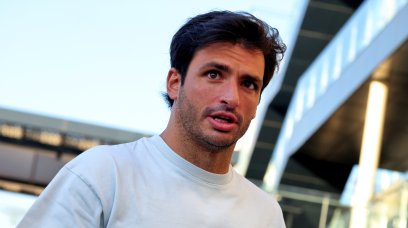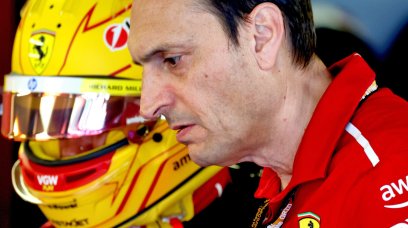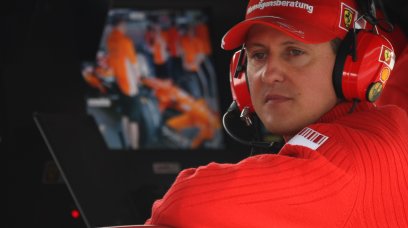Whose launch was it anyway?
Formula 1 CEO Stefano Domenicali’s non-stage appearance during Ford’s F1 return announcement in New York’s Classic Car Club certainly set tongues wagging. But the word is the Italian had been lured to the Big Apple for the Blue Oval’s shindig, then discovered the event was simultaneously a season preview for reigning champions Red Bull. Thus, he did not wish to be seen to be publicly endorsing a particular team. Sources say he was in a Sirius radio interview when called on-stage. One wonders whether referencing a radio station that falls within Liberty Media’s portfolio is a convenience… Whatever, within minutes of tuning into the launch on YouTube it was clear to fans this was not the usual edgy Red Bull launch, but a tedious corporate trot-out. The event was clearly hijacked by Ford; indeed, the only press releases were on Blue Oval stationery, distributed under embargo to select outlets – then leaked by an Italian news outlet a day early, which stole all of Ford’s (and the media's) thunder. Every angle of the function was simply cack-handed, from press conferences that ran an hour late through an American moderator who was clearly out of his depth when it came to F1, to Ford’s smooth US-style PR patter that cut little ice with fans. Folk who experienced Red Bull at its pomp know this is not the team’s usual way - suggesting Ford’s meddling screwed the day for both parties. Ironically, Ford’s name replaces Porsche logo on Red Bull’s power units from 2026 after the Austrian team and German car company could not agree on overall control of their proposed partnership. Hopefully Red Bull gains better control over this partnership than what was evident on Friday in New York.
Who goes where in 2026?
After the FIA’s double whammy this week of announcing the new teams Expression of Interest process and confirmation that six power unit suppliers had registered for the F1’s PU2026 regulations , the obvious question is: Who goes where? Assuming the FIA selects two newcomer teams - making for 12 team grids - simple mathematics dictates an average of two teams per PU supplier. However, F1 is never simple; indeed, the greater the complications, the greater the self-satisfaction in the paddock. That Red Bull and AlphaTauri will be powered by in-house Red Bull-Ford units is a given (provided rumours that the latter team is for sale are untrue) while Ferrari will stick to in-house power units, also supplying Haas. That makes four teams and two PU suppliers sorted. Audi will be powered by Audi, and Alpine by its own PUs, to be known as Alpine come 2026, not Renault as currently. That the Mercedes/Toto Wolff/INEOS constellation will stick to Mercedes HPP PUs is clear, making for seven teams in total – leaving Aston Martin, McLaren, Williams plus two newcomers to fight for Honda deals and scraps from Audi, Alpine and Mercedes. Given the latter’s shareholding/technical agreement with Aston Martin that box is ticked – leaving a two-team Honda supply and one each for Audi and Alpine. How these four deals get carved up is intriguing; here’s betting unusual partnerships will eventuate.
Will they stay the distance?
Much is made by F1 and FIA about six automotive brands gearing up for PU2026. Cadillac is potentially the seventh in cooperation with another PU supplier - likely Alpine or Honda - while Alfa Romeo is keen to remain, possibly switching to Haas-Ferrari, whose Moneygram livery perfectly matches the Italian brand’s colours. All good and well, but the trick will be to retain them all, particularly those with no hardware in the game. Regardless of whether said brands have their own facilities or ride on the back of other projects, F1’s global reach means billions of eyeballs on engine covers. Yet, it stands to reason that a brand will come last (12th or even 13th) in the Constructors' and so forth, with some not even making it to the podium. At that stage, bean-counters and marketeers question whether F1 is such a wonderful investment given the resulting embarrassment for their brand, followed by gradual exits by unsuccessful projects - particularly those with joint venture ‘badging’ deals. Damage limitation, in other words. F1 has been here before, as has Formula E: After initial flurries of excitement during the early 2000s, Jaguar (Ford), BMW, Honda and Toyota left F1 - with just two victories amongst them in eight years - reducing the sport to three PU suppliers by 2010. Where FE had 12 teams and 10 PU suppliers in 2018 it is now down to 11 and seven respectively, and likely to reduce further despite the lower costs of the electric racing series. The burning question is what happens if a F1 PU brand unexpectedly departs; who steps into the breach and on what basis? Under the PU cap, the suppliers will have downsized to fulfil only contractual commitments - and will be hard pushed to suddenly ramp up supply for another two (or four) cars. Expect wrangling to start.
Most read







